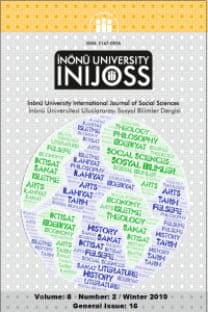ARABIC MORPHEMES AND MACHINE TRANSLATION
Öz
This article
aims to familiarize lecturers and researchers with the ambiguities of the
Machine translation and to make understand the importance of the morphemes
functions to identify words and later sentences’ syntax, grammar and meanings.
This manner to do is also useful to learn or teach Arabic, because it gives
another way to approach linguistics or simply languages. Therefore, for the
Arabic language, letters and short vowels are important for lexical and
syntactic understanding, for that we should not neglect any of them. For the
Turkish language, machine translation encounters same difficulties and more,
because of its unusual syntax for Arabs and European people, so we need to
think differently to resolve teaching and translation problems. We have the
lexical ambiguity, which is introducing word into the syntax, which should be
able to link between syntax’s words to give the appropriate meaning. This work
is trying to open a window to look through it to the language as machine can
look and see it. The Machine
Translation is one application among many ones what concern languages’
engineering. All of them use languages’ process. ……. I begin by introducing an example to illustrate this big
science. The problem of the Machine Translation or any processing system is to
be able to identify words individually in sentence and combine between them to
get the possible meanings. Therefore, there are many problems, to reach this
goal. We call these problems ambiguities. I had defined
in my researches, in Lucien Tesnière researches centre, a typology of
ambiguities that we encounter in Machine Translation, with goals to improve
translation’s quality. One of these ambiguities is the segmental ambiguity; it
means how we should segment a word that we want to identify or we cannot
identify, as a unit. We take this lexis to illustrate this ambiguity. This
word: “أقال” How it should be identified? The system
(the computer) will identify it as one word that means “Dismiss”, but depending
of its syntax, this identification can be an error. So lexical identifications
can be limited by their syntaxes and meanings. If we say
“أقال المدير الموظف”, if this sentence is limited to theses vocabulary, our
first identification (dismiss
=أقال) is right; and in this case, it means, “The director dismissed the
employee.” Moreover, this is a right translation.
But if the sentence is “أقال الطالب ال
Anahtar Kelimeler:
ARABIC MORPHEMES AND MACHINE TRANSLATION
___
Baudouin Joseph-Gabriel, (2011), Morphemes and grammatical functions in Arabic, SOAS LFG meeting, 05 March 2011, London, UK. Baudouin Joseph-Gabriel, (2010), Les ambiguïtés de la langue arabe pour un traitement automatique, Éditions Universitaires Européennes, Sarrebruck, Allemagne. Baudouin Joseph-Gabriel, (2008), Désamiguïsation morphologique de l'arabe (Arabic’s morphological disambiguation), Deuxième colloque international en traductologie et TAL, 7-8 juin 2008, Oran, Algérie. Baudouin Joseph-Gabriel, (2007), La lexie, sa graphie, sa morphologie, ses affixations, sa syntaxe, sa grammaire et sa sémantique (Lexis, its written form, its morphology, its affixations, its syntax, its grammar and its semantics), Colloque international en traductologie et TAL, 9-11.04.2007, Oran, Algérie. Al-Labdī Mohammad, le dictionnaire de la terminologie grammaticale (Mucğam al-muṣṭalaḥāt an-naḥawiyya wa aṣ-ṣarfiyya), Beyrouth, Mu'asasat ar-risala, 1986 Chenfour Noureddine, Harti Mostafa, Tahir Youssef, Modélisation à objets d’une base de données morphologique pour la langue arabe, JEP-TALN 2004, Traitement Automatique de l’Arabe, Fès, 19-22 avril 2004. Aloulou Chafik, Analyse syntaxique de l’Arabe : Le système MASPAR, Récital 2003, Batz-sur-Mer, 11-12 juin 2003. http://www.sciences.univ-nantes.fr/irin/taln2003/articels/aloulou.pdf.- ISSN: 2147-0936
- Yayın Aralığı: Yılda 2 Sayı
- Yayıncı: İnönü Üniversitesi
Sayıdaki Diğer Makaleler
BANKACILIK SİSTEMİNDE İNTERNETİN OLUMLU VE OLUMSUZ YÖNLERİ
MÂVERDÎ VE EL-AHKÂMU’S-SULTANİYYESİ
ALMAN MİLLİYETÇİLİĞİNİN TARİHSEL KÖKENLERİ
KAPİTALİZM’İN KARL MARX’A VE IMMANUEL WALLERSTEİN’A GÖRE KISA BİR ANALİZİ
SOSYAL AĞLARDA GİZLİLİK KAYGISININ ÖLÇÜLMESİ: İNÖNÜ ÜNİVERSİTESİ ÖĞRENCİLERİNE YÖNELİK BİR ARAŞTIRMA
DESPİNA HATUN’UN MEZARI MESELESİ
SPINOZA ATEİST MİDİR? L. STRAUSS, E.E. HARRIS’E KARŞI
Emin ÇELEBİ, Osman Gazi BİRGÜL
AFGANİSTAN, HİNDİSTAN VE PAKİSTAN’IN TARİH ÖNCESİNDE ARKEOLOJİ VE METAL TEKNOLOJİSİ
OYUN DESTEKLİ EĞİTİM YOLUYLA SANAT TABANLI BİR UYGULAMA (WORKSHOP)
